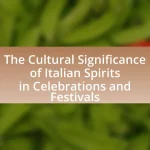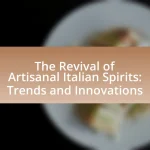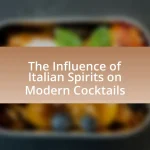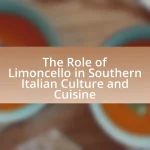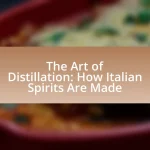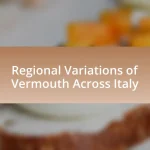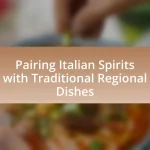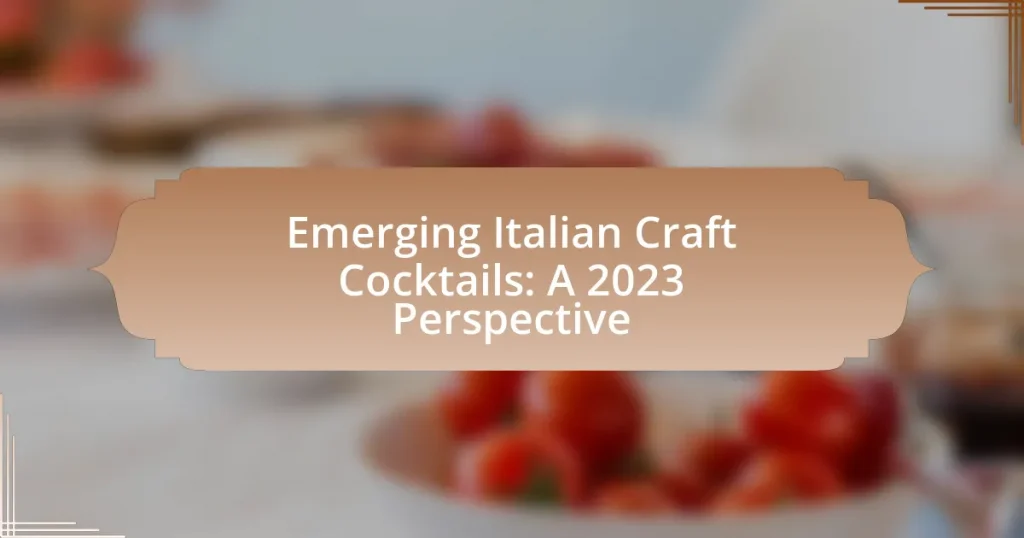Emerging Italian craft cocktails in 2023 showcase innovative drinks that emphasize regional ingredients and traditional spirits, such as the Negroni Sbagliato and Spritz al Limone. The article explores the evolution of Italian craft cocktails, highlighting the resurgence of traditional ingredients, sustainability practices, and the influence of historical elements on contemporary mixology. It also discusses the characteristics of Italian craft cocktails, including the use of high-quality, locally sourced ingredients, and the role of presentation and garnishing. Additionally, the article examines key trends, innovative techniques adopted by mixologists, and the growing global popularity of Italian cocktails, providing insights into how to experience and recreate these drinks at home.
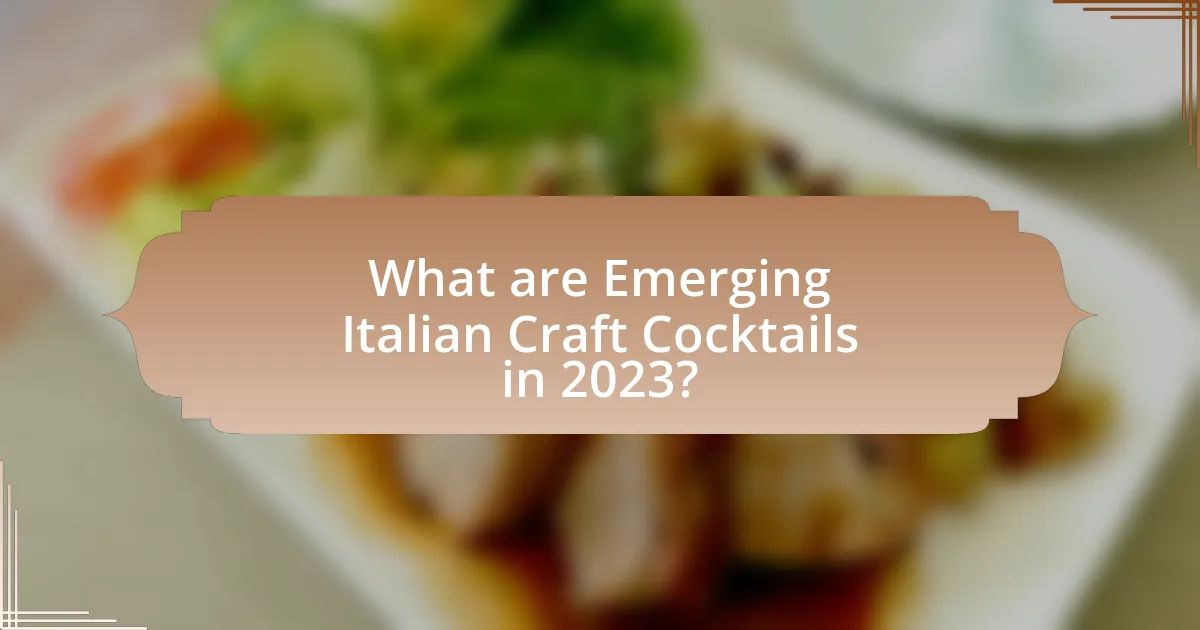
What are Emerging Italian Craft Cocktails in 2023?
Emerging Italian craft cocktails in 2023 include innovative drinks that highlight regional ingredients and traditional Italian spirits. Notable examples are the “Negroni Sbagliato,” which substitutes prosecco for gin, and the “Spritz al Limone,” featuring fresh lemon juice and local liqueurs. These cocktails reflect a trend towards using high-quality, locally sourced components, such as artisanal vermouths and unique bitters, enhancing the depth of flavor and authenticity. The rise of craft cocktail bars across Italy has further popularized these creations, showcasing a blend of classic techniques and modern twists.
How have Italian craft cocktails evolved in recent years?
Italian craft cocktails have evolved significantly in recent years, marked by a resurgence of traditional ingredients and innovative techniques. This evolution reflects a growing emphasis on local and seasonal products, with bartenders increasingly incorporating artisanal spirits, homemade syrups, and fresh herbs into their creations. For instance, the use of Italian vermouth has gained popularity, with brands like Carpano and Cocchi leading the way in crafting high-quality, regionally inspired options. Additionally, the trend of sustainability has influenced cocktail menus, as establishments prioritize eco-friendly practices and reduce waste through creative ingredient usage. This shift not only enhances flavor profiles but also aligns with consumer preferences for authenticity and sustainability in dining experiences.
What historical influences shape the current cocktail scene in Italy?
The current cocktail scene in Italy is shaped by historical influences such as the Italian Renaissance, the introduction of vermouth in the 18th century, and the global spread of Italian aperitivo culture. The Italian Renaissance fostered a culture of innovation in gastronomy and mixology, leading to the creation of sophisticated drinks. The emergence of vermouth, particularly in Turin, established a foundation for many classic cocktails, including the Martini and Negroni. Additionally, the aperitivo tradition, which dates back to the 19th century, emphasizes socializing over drinks before meals, influencing contemporary cocktail culture by promoting a relaxed, communal drinking experience. These historical elements collectively contribute to the rich and evolving cocktail landscape in Italy today.
How do modern trends impact traditional Italian cocktail recipes?
Modern trends significantly influence traditional Italian cocktail recipes by introducing innovative ingredients and techniques that enhance flavor profiles and presentation. For instance, the rise of craft spirits has led to the incorporation of artisanal gins and vermouths, which offer unique botanical flavors that were not traditionally used in classic recipes. Additionally, the trend towards sustainability has prompted bartenders to utilize local and seasonal ingredients, resulting in cocktails that reflect contemporary tastes while honoring traditional Italian roots. This blending of old and new not only revitalizes classic cocktails but also appeals to a modern audience seeking authenticity and creativity in their drinking experiences.
What defines the characteristics of Italian craft cocktails?
Italian craft cocktails are characterized by their emphasis on high-quality, locally sourced ingredients, traditional techniques, and a focus on balance and flavor. The use of regional spirits, such as vermouth and amaro, along with fresh herbs and seasonal fruits, enhances the authenticity and complexity of these cocktails. Additionally, Italian craft cocktails often incorporate a minimalist approach to presentation, highlighting the drink’s ingredients rather than elaborate garnishes. This focus on quality and simplicity reflects Italy’s rich culinary heritage and commitment to craftsmanship in beverage preparation.
What ingredients are commonly used in these cocktails?
Common ingredients used in emerging Italian craft cocktails include vermouth, amaro, fresh citrus juices, and high-quality spirits such as gin and vodka. Vermouth serves as a key base in many Italian cocktails, providing herbal and aromatic flavors. Amaro, a bitter liqueur, adds complexity and depth, while fresh citrus juices like lemon and orange enhance the cocktails’ brightness. High-quality spirits contribute to the overall balance and character of these drinks, reflecting the Italian emphasis on quality ingredients.
How do presentation and garnishing play a role in Italian craft cocktails?
Presentation and garnishing are crucial in Italian craft cocktails as they enhance the visual appeal and elevate the overall drinking experience. The aesthetic presentation reflects the artistry and tradition of Italian mixology, often incorporating vibrant colors and intricate designs that attract attention. For instance, the use of fresh herbs, citrus peels, or edible flowers not only adds flavor but also creates a sensory experience that engages the drinker. This emphasis on visual elements aligns with Italy’s cultural appreciation for beauty and craftsmanship, making the cocktail not just a beverage but a work of art. Additionally, studies show that visually appealing drinks can enhance perceived taste and enjoyment, reinforcing the importance of presentation and garnishing in the craft cocktail scene.
Why are Italian craft cocktails gaining popularity globally?
Italian craft cocktails are gaining popularity globally due to their unique flavors, high-quality ingredients, and the cultural heritage associated with Italian mixology. The emphasis on fresh, local ingredients and traditional techniques enhances the overall drinking experience, appealing to consumers seeking authenticity and sophistication. Additionally, the rise of social media and cocktail culture has facilitated the sharing of Italian cocktail recipes and experiences, further driving interest. According to a 2022 report by the International Bartenders Association, Italian cocktails have seen a 30% increase in global mentions on social media platforms, highlighting their growing influence and appeal.
What cultural factors contribute to the rise of Italian cocktails outside Italy?
The rise of Italian cocktails outside Italy is primarily driven by the global fascination with Italian cuisine and lifestyle. This cultural appreciation has led to an increased demand for authentic Italian experiences, including cocktails like Negronis and Spritzes. The popularity of Italian aperitivo culture, which emphasizes socializing and enjoying drinks before meals, has also influenced cocktail trends worldwide. Additionally, the craft cocktail movement has embraced Italian ingredients and techniques, further integrating these cocktails into bars and restaurants globally. The combination of these cultural factors has significantly contributed to the growing presence of Italian cocktails in international markets.
How do social media and influencers affect the perception of Italian craft cocktails?
Social media and influencers significantly shape the perception of Italian craft cocktails by amplifying their visibility and desirability. Platforms like Instagram and TikTok allow influencers to showcase visually appealing cocktails, often highlighting unique ingredients and artisanal techniques, which enhances the allure of these drinks. For instance, a study by the Journal of Consumer Research found that visual content on social media can increase consumer interest and perceived quality of products, including beverages. This exposure leads to a heightened appreciation for the craftsmanship behind Italian cocktails, influencing consumer preferences and trends in the cocktail industry.
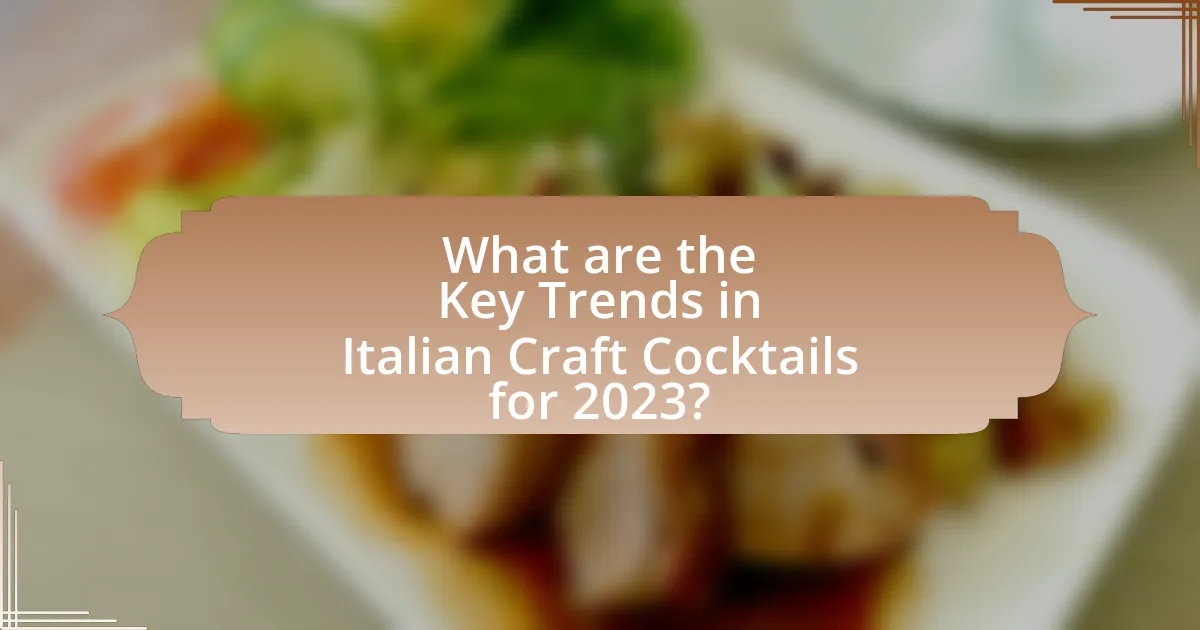
What are the Key Trends in Italian Craft Cocktails for 2023?
Key trends in Italian craft cocktails for 2023 include a focus on sustainability, the use of local and seasonal ingredients, and the revival of classic Italian aperitifs. Sustainability is emphasized through eco-friendly practices, such as minimizing waste and sourcing organic products. The trend of using local and seasonal ingredients enhances flavor profiles and supports regional agriculture. Additionally, classic Italian aperitifs, like Negroni and Spritz, are being reimagined with innovative twists, reflecting a blend of tradition and modernity in cocktail culture. These trends are supported by the growing consumer demand for authenticity and quality in beverage choices.
How are sustainability practices influencing cocktail creation?
Sustainability practices are significantly influencing cocktail creation by encouraging the use of local, organic ingredients and reducing waste. Bartenders are increasingly sourcing seasonal produce from nearby farms, which not only supports local economies but also minimizes the carbon footprint associated with transportation. For instance, the use of foraged herbs and fruits in cocktails exemplifies this trend, as it promotes biodiversity and reduces reliance on mass-produced ingredients. Additionally, many establishments are implementing practices such as composting and recycling to manage waste effectively, which aligns with the growing consumer demand for environmentally responsible dining experiences. This shift towards sustainability is reflected in the rise of eco-friendly cocktail menus that highlight these practices, demonstrating a commitment to both quality and environmental stewardship.
What local ingredients are being prioritized in Italian craft cocktails?
Italian craft cocktails are prioritizing local ingredients such as regional spirits, fresh herbs, and seasonal fruits. These ingredients reflect Italy’s diverse agricultural landscape and culinary traditions, enhancing the authenticity and flavor profiles of the cocktails. For instance, spirits like Grappa and Amaro, which are produced in specific Italian regions, are commonly used. Additionally, herbs such as basil and rosemary, along with fruits like blood oranges and lemons, are sourced locally to create vibrant and unique flavor combinations that celebrate Italy’s rich terroir.
How does the zero-waste movement impact cocktail bars in Italy?
The zero-waste movement significantly impacts cocktail bars in Italy by encouraging sustainable practices that minimize waste and promote resourcefulness. Many Italian cocktail bars are adopting techniques such as using leftover ingredients from food preparation in their cocktails, which not only reduces waste but also enhances flavor profiles. For instance, bars are incorporating citrus peels, herb stems, and even spent coffee grounds into their drinks, showcasing creativity while adhering to sustainability principles. This shift aligns with a broader trend in Italy, where the culinary culture increasingly values local sourcing and environmental responsibility, as evidenced by initiatives like the “Cucina Povera” philosophy that emphasizes using every part of an ingredient.
What innovative techniques are being adopted by Italian mixologists?
Italian mixologists are adopting innovative techniques such as molecular mixology, barrel-aging cocktails, and the use of local, seasonal ingredients. Molecular mixology allows for the creation of unique textures and flavors through techniques like spherification and foaming, enhancing the sensory experience of cocktails. Barrel-aging, which involves aging cocktails in wooden barrels, adds complexity and depth to flavors, a practice inspired by traditional aging methods in wine and spirits. Additionally, the emphasis on local and seasonal ingredients reflects a commitment to sustainability and authenticity, aligning with Italy’s culinary heritage. These techniques are reshaping the cocktail landscape in Italy, making it a hub for creative and artisanal drink-making.
How does molecular gastronomy play a role in cocktail preparation?
Molecular gastronomy significantly enhances cocktail preparation by employing scientific techniques to manipulate flavors, textures, and presentations. This culinary approach allows bartenders to create innovative drinks that engage the senses, such as using spherification to form flavor-filled spheres or foams that add unique textures. For instance, the use of liquid nitrogen can create instant frozen cocktails, while emulsification techniques can produce stable flavor-infused foams. These methods not only elevate the drinking experience but also encourage creativity and experimentation in crafting cocktails, aligning with the trends in emerging Italian craft cocktails in 2023.
What are the emerging flavor profiles in Italian craft cocktails?
Emerging flavor profiles in Italian craft cocktails include herbal, citrus, and bitter notes, often enhanced by unique ingredients like amaro, vermouth, and regional spirits. These profiles reflect a trend towards complex, layered flavors that emphasize freshness and local sourcing. For instance, the use of ingredients such as basil, rosemary, and citrus fruits showcases Italy’s rich botanical heritage, while the revival of traditional bitters adds depth and balance to cocktails. This evolution aligns with the growing interest in artisanal and locally produced spirits, as seen in the increasing popularity of craft distilleries across Italy.
What role do Italian spirits play in the cocktail renaissance?
Italian spirits are central to the cocktail renaissance, significantly influencing contemporary mixology. Their unique flavors and traditional production methods enhance cocktail complexity, making them essential for innovative drink recipes. For instance, spirits like Amaro and Aperol have gained popularity for their bittersweet profiles, which are integral to modern cocktails such as the Negroni and Spritz. The resurgence of interest in Italian spirits reflects a broader trend towards artisanal and craft beverages, as seen in the increasing number of bars specializing in Italian cocktails and the rise of Italian-inspired cocktail competitions globally.
Which Italian spirits are becoming staples in craft cocktails?
Italian spirits that are becoming staples in craft cocktails include Amaro, Aperol, and Fernet. Amaro, a herbal liqueur, is widely used for its complex flavors and versatility in cocktails, often featured in drinks like the Negroni. Aperol, known for its bright orange color and bittersweet taste, has gained popularity in cocktails such as the Aperol Spritz, especially during summer months. Fernet, a bitter, aromatic spirit, is increasingly used in cocktails for its bold flavor profile, often found in drinks like the Toronto. These spirits are recognized for their unique characteristics and have been embraced by mixologists, contributing to the evolving landscape of craft cocktails.
How are traditional Italian liqueurs being reimagined in modern cocktails?
Traditional Italian liqueurs are being reimagined in modern cocktails by incorporating innovative flavor pairings and contemporary mixology techniques. Bartenders are blending classic liqueurs like Amaro, Limoncello, and Fernet with fresh ingredients, artisanal spirits, and unique bitters to create balanced and complex drinks. For instance, Amaro is often used in craft cocktails to add depth and herbal notes, while Limoncello is being combined with sparkling wines and fresh herbs for refreshing spritzes. This evolution reflects a growing trend in the cocktail industry to honor traditional flavors while appealing to modern palates, as evidenced by the increasing popularity of Italian-inspired cocktails in bars and restaurants worldwide.
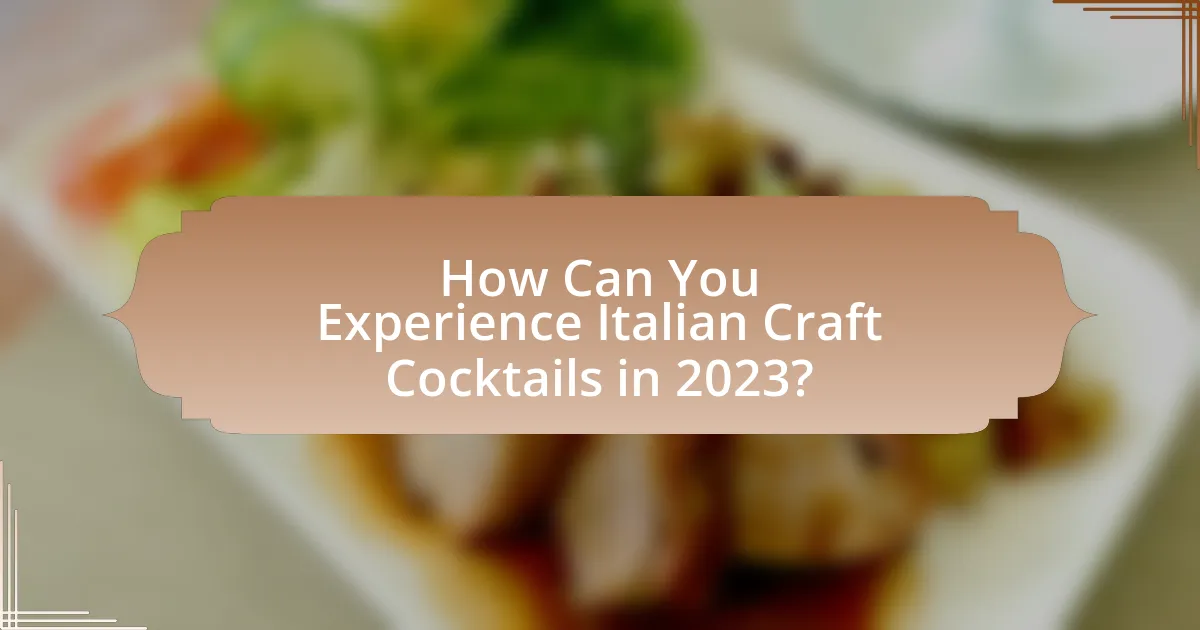
How Can You Experience Italian Craft Cocktails in 2023?
To experience Italian craft cocktails in 2023, visit specialized bars and restaurants that focus on authentic Italian mixology. These establishments often feature skilled bartenders trained in traditional Italian techniques and utilize high-quality, locally sourced ingredients. For instance, cities like Milan and Florence have seen a rise in cocktail bars that emphasize regional spirits such as Amaro and Vermouth, showcasing Italy’s rich cocktail heritage. Additionally, participating in cocktail workshops or tasting events can provide hands-on experience and deeper insights into the craft.
What are the best bars and venues to explore Italian craft cocktails?
The best bars and venues to explore Italian craft cocktails include Bar Basso in Milan, known for its iconic Negroni Sbagliato, and The Jerry Thomas Project in Rome, celebrated for its innovative mixology techniques. These venues exemplify the resurgence of Italian cocktail culture, with Bar Basso being a pioneer since the 1960s and The Jerry Thomas Project being recognized as one of the top bars in the world for its commitment to quality and creativity. Additionally, the recently opened Drink Kong in Rome offers a modern twist on classic Italian cocktails, further showcasing the evolution of this craft.
Which cities in Italy are known for their innovative cocktail scenes?
Milan, Florence, and Rome are cities in Italy known for their innovative cocktail scenes. Milan is recognized for its modern mixology and upscale bars, often featuring unique ingredients and techniques. Florence boasts a vibrant cocktail culture that blends traditional Italian flavors with contemporary twists, while Rome is celebrated for its classic cocktails reimagined with local ingredients and innovative presentations. These cities have gained international attention for their creativity and quality in cocktail crafting, making them key players in the global cocktail landscape.
What should you look for in a bar specializing in craft cocktails?
In a bar specializing in craft cocktails, you should look for a well-curated menu that emphasizes quality ingredients and innovative techniques. A focus on fresh, seasonal produce and artisanal spirits is essential, as these elements contribute to the unique flavor profiles of craft cocktails. Additionally, skilled bartenders who are knowledgeable about mixology and can create bespoke drinks based on customer preferences enhance the overall experience. The bar’s ambiance should also reflect a commitment to the craft, often featuring a stylish design that complements the cocktail offerings. Establishments that participate in local sourcing and sustainable practices further demonstrate their dedication to quality and community.
How can you recreate Italian craft cocktails at home?
To recreate Italian craft cocktails at home, start by sourcing authentic ingredients such as Italian spirits, vermouth, and fresh herbs. Use high-quality products like Campari, Aperol, or Italian gin, which are essential for classic cocktails like Negroni or Spritz. Follow traditional recipes, ensuring precise measurements and techniques, such as stirring or muddling, to achieve the desired flavor profile. For example, a Negroni requires equal parts gin, Campari, and sweet vermouth, stirred with ice and garnished with an orange peel. This method reflects the craftsmanship and attention to detail characteristic of Italian cocktail culture, which emphasizes balance and quality.
What essential tools and ingredients do you need for crafting cocktails?
To craft cocktails, essential tools include a cocktail shaker, jigger, strainer, muddler, and bar spoon, while key ingredients consist of spirits, mixers, bitters, fresh fruits, and garnishes. The cocktail shaker allows for effective mixing and chilling of ingredients, while the jigger ensures precise measurement of spirits. A strainer is necessary for separating liquid from solids, and a muddler helps release flavors from herbs and fruits. Spirits like vodka, gin, rum, tequila, and whiskey form the base of most cocktails, complemented by mixers such as tonic water, soda, and juices. Bitters add complexity, and fresh fruits and garnishes enhance presentation and flavor. These tools and ingredients are foundational for creating a diverse range of cocktails, reflecting the evolving trends in mixology, particularly in the context of Italian craft cocktails in 2023.
What are some classic Italian cocktail recipes to try?
Classic Italian cocktail recipes to try include the Negroni, Spritz, and Americano. The Negroni is made with equal parts gin, Campari, and sweet vermouth, garnished with an orange slice, and is known for its bitter-sweet flavor profile. The Spritz, particularly the Aperol Spritz, combines Aperol, prosecco, and soda water, served over ice with an orange slice, making it a refreshing choice. The Americano consists of Campari, sweet vermouth, and soda water, garnished with a lemon twist, and offers a lighter alternative to the Negroni. These cocktails are rooted in Italian culture and are popular for their distinctive flavors and simplicity.
What tips can enhance your appreciation of Italian craft cocktails?
To enhance your appreciation of Italian craft cocktails, focus on understanding the ingredients and techniques unique to Italian mixology. Italian craft cocktails often emphasize high-quality spirits, fresh ingredients, and traditional methods, such as the use of aperitifs like Campari and vermouth. Familiarizing yourself with regional variations and the cultural significance of these drinks can deepen your experience. For instance, knowing that the Negroni originated in Florence in the early 20th century adds historical context to its enjoyment. Additionally, attending tastings or workshops led by skilled bartenders can provide hands-on experience and insights into the craft, further enriching your appreciation.
How can you pair Italian craft cocktails with food for a complete experience?
Pairing Italian craft cocktails with food enhances the dining experience by complementing flavors and textures. For instance, a Negroni, with its bitter and herbal notes, pairs well with rich dishes like risotto or charcuterie, as the cocktail’s complexity balances the richness of the food. Similarly, a Spritz, characterized by its refreshing and citrusy profile, complements lighter fare such as seafood or salads, enhancing the freshness of the ingredients. This approach is supported by the Italian culinary tradition, which emphasizes harmony between food and drink, ensuring that each element elevates the other for a cohesive dining experience.
What common mistakes should you avoid when making Italian craft cocktails?
Common mistakes to avoid when making Italian craft cocktails include using low-quality ingredients, neglecting proper measurements, and failing to balance flavors. High-quality ingredients are essential, as they directly impact the cocktail’s taste; for example, using fresh herbs and premium spirits enhances the overall experience. Accurate measurements are crucial because imprecise ratios can lead to unbalanced cocktails, which is particularly important in Italian mixology where harmony of flavors is key. Additionally, overlooking the importance of garnishes can detract from the visual appeal and aromatic experience, both of which are significant in Italian cocktail culture.
